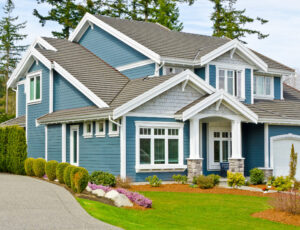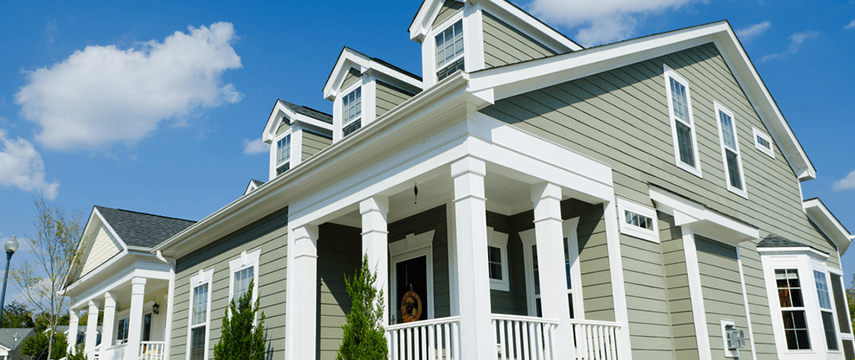Whether you’re building a new house, remodeling, or just performing some touch-ups, one of the biggest things to consider is siding color. Your siding has a big visual impact on your home, so understanding how to choose siding color is essential.
Why is Siding Important?
Siding is an important part of your house because it has both functional and cosmetic value.
1. Protection From the Elements
Siding is your first line of defense against the elements. It prevents snow, rain, wind, and dirt from getting into your house. This helps avoid leaks and prevents mold from building up. It also acts as pest control by deterring insects. Another benefit is it keeps your home insulated.
2. Impacts Curb Appeal
The exterior of your home is the first thing people see—including potential buyers. Your siding choices have the chance to make a memorable first impression by enhancing curb appeal. Attractive siding is a benefit not just to you, but also to your neighbors. On the other hand, an old and dirty house can be an eyesore.
3. Affects Resale Value
Sprucing up your exterior is a great way to add value to your home. While updating your siding could have up to a 95% return on investment, the color makes a big difference when it comes to resale value. Factors like location and the housing market will impact this, but neutrals are always a safe option because they are timeless and enjoyed by all.
How to Choose Siding Color for Your Home
Siding color isn’t just for aesthetic purposes—there are also practical factors that impact the decision. Here is our list of top things to consider when choosing siding color.
What Material Are You Using?
Siding comes in many different materials, from wood and metal to vinyl and stucco. Each material has its own set of colors, so that will limit your choices. Because of its low cost and easy maintenance, vinyl siding is the most popular choice among homeowners.
Vinyl siding usually comes in a range of neutral, earthy colors. Use vinyl-safe paint to expand your options.
What Climate Do You Live In?
The weather in your region will also impact how to choose a siding color. If you live in an area with high winds and frequent storms, your siding will not last as long. As we said above, light colored siding will show more dirt and wear, so a dark color may be better.
Also, think about sun exposure. Dark colors fade over time when in direct sunlight, so if you live in a hot, sunny area, dark siding may require touch-ups.
What is Most Energy Efficient?
Looking to cut down on your electricity bill? Your siding color has a huge impact on the energy efficiency of your home. Remember that dark colors absorb heat and light colors reflect it. If you live in a cold climate and want to retain heat, dark colors are your best option. If you’re looking to keep cool, choose a lighter color.
What is Your Maintenance Schedule?
When it comes to maintenance, not all siding colors are created equal. Stark white shows the most dirt, mold, and mildew. It will require more cleaning to keep its pristine look. As an alternative, off-white hues like gray, beige, light blue, and sage are still classic, but hide dirt better.

What Colors are Your Home Currently?
Most houses have three main colors: body, trim, and accent. Whatever body color you pick needs to complement your roof material, shutters, doors, and trim. Some tips to remember:
- Most people with a dark roof opt for lighter siding.
- Lighter trim draws attention to it.
- Use accent colors to highlight special details.
When choosing siding colors for your home, think about what colors pair well together. You don’t have to be a color theory expert to find ones that complement each other.
What Size is Your Home?
The size of your home is another consideration when choosing siding color. If you have a large house, dark siding may feel overpowering. On the other hand, light siding on a small house will make it not stand out. A higher contrast between your body and trim will make your home look smaller, and a soft contrast will make it appear larger.
What’s the Style of Your House and Neighborhood?
If you’re struggling with how to choose siding color, draw ideas from your home’s architectural style. For more traditional styles, such as Colonial or Farmhouse, you may want to choose a classic color palette. On the other hand, Victorian houses tend to be bold and play with color.
If your home includes exposed beam or stone accents, such as Midcentury Modern or Craftsman, choose a color that makes those accents pop. Also, consider your neighborhood as a whole. Is it filled with eclectic houses, or is it more muted and traditional? Explore your street and get inspiration from your neighbors!
Before getting started on your new siding color, always check with your Homeowners Association (HOA). Some HOAs have a list of approved colors to choose from, or even require specific colors and brands for your siding and roof. Ensure your vision is in-line with HOA rules so you don’t get fined.
What’s Your Landscaping Like?
Remember, your home and yard go hand-in-hand. Think about the most prominent colors in your landscaping throughout the year as seasons change. Also consider the color of your patio, driveway, sidewalk, and other outdoor features.
For lush green yards, we recommend cool, calming colors like light blues, grays, and greens. For a flower-filled area, lean more muted to balance the vibrancy of the blossoms. Beiges, grays, or pale blues are a solid choice. If your landscaping is more earthy, embrace natural tones like deep greens or warm browns.
What Do You Like Best?
When figuring out how to choose exterior siding colors, you can’t forget about personal preference. Do you prefer bold color combos or muted ones? Do you like warm tones or cool tones? Do you want to blend in or stand out? Ultimately, the choice is up to you. Choose something that matches your style and catches your eye.
Don’t be afraid to get creative and try something different. Get inspiration from these unique color palettes.
Trying to picture your vision come to life? Another great tool to help when choosing siding colors for your home is using a visualizer. Check out CertainTeed’s free COLORVIEW® tool to explore how different colors and styles will look on your home.

